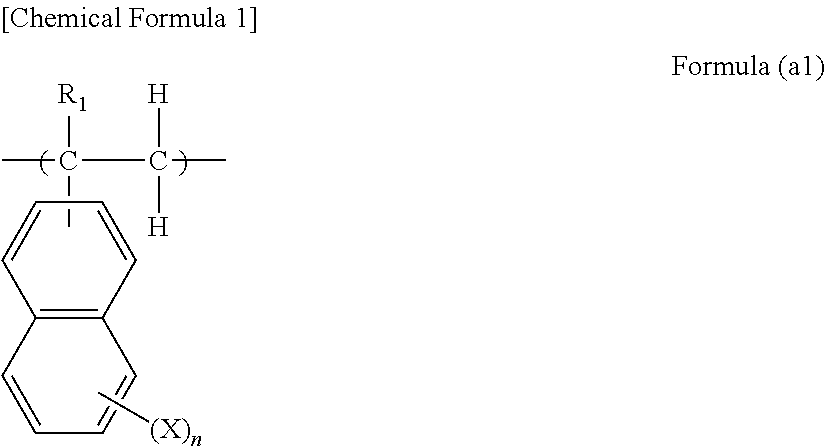Method for manufacturing semiconductor device using quadruple-layer laminate
a semiconductor and quadruple-layer technology, applied in the direction of photosensitive materials, photomechanical devices, instruments, etc., can solve the problem of difficult to apply materials for organic-based anti-reflective films on substrates having a high aspect ratio, and the influence of actinic ray reflection on semiconductor substrates has become a serious problem, so as to improve the focus depth margin of a photoresist
- Summary
- Abstract
- Description
- Claims
- Application Information
AI Technical Summary
Benefits of technology
Problems solved by technology
Method used
Image
Examples
synthesis example 1
Production of an Organic Antireflective Film (Layer C) Forming Composition
[0312]
[0313]After 6.6 g (0.039 mole) of butyrolactone methacrylate of the above formula (1), 6.6 g (0.046 mole) of hydroxypropyl methacrylate and 6.8 g (0.039 mole) of benzyl methacrylate were dissolved in 64.4 g of tetrahydrofuran, an atmosphere in the flask was replaced with nitrogen and the temperature of the mixture was raised to the reflux temperature. After starting the reflux, 0.2 g of azo-bis-isobutyronitrile (AIBN) dissolved in 10 g of tetrahydrofuran were added under nitrogen pressure, and the mixture was reacted for 24 hours. After cooling the reaction solution, the solution was poured into diethyl ether to reprecipitate a polymer, and the polymer was dried by heating to obtain the resin of a formula (2). The obtained resin had a degree of polymerization of 490 and a weight average molecular weight (Mw) of 80000 (polystyrene conversion). A ratio of x:y1:y2 was 31%:38%:31% and a yield was 90%.
[0314]4...
synthesis example 2
Production of a Silicon-Containing Hard Mask (Layer B) Forming Composition
[0315]4.00 g of phenyltrimethoxysilane, 10.99 g of methyltriethoxysilane, 15.35 g of tetramethoxysilane, 7.08 g of water and 0.365 g of p-toluenesulfonic acid were added to 40.71 g of propylene glycol monomethyl ether. The mixture was stirred for 1 hour at 80° C. to obtain the resin of a formula (3). In the formula (3), a ratio of S1:S2:S3 is 11%:33%:56%. The obtained polysiloxane resin in the formula (3) had a weight average molecular weight of 11000 and a number average molecular weight of 3400.
[0316]Then, 0.195 g of p-toluenesulfonic acid, 2.68 g of propylene glycol monomethyl ether, 8.78 g of propylene glycol monomethyl ether acetate and 17.5 g of cyclohexanone were added to 10 g of the reaction solution having a concentration of solid content of 39% by mass to be a 10.0% by mass solution. The solution was filtrated by using a microfilter made of polyethylene having a pore diameter of 0.2 μm to obtain the ...
synthesis example 3
Production of a Silicon-Containing Hard Mask (Layer B) Forming Composition
[0317]5.0 g of a polysilane compound SI-2020 (manufactured by Osaka Gas Chemicals Co., Ltd., a weight average molecule weight: 5900, number average molecule weight: 1800, a ratio of X:Y in the polysilane of a formula (4) is 50%:50%, both terminals have silanol groups) having the unit structure of the formula (4),
5.0 g of KN 030 (manufactured by Osaka Organic Chemical Industry Ltd., a component is a copolymer of naphthol novolac and cresol novolac, and a ratio of copolymer is naphthol novolac of 70 mol % and cresol novolac of 30 mol %, and a weight average molecule weight is 1500), and 2.50 g of tetramethoxymethyl glycoluryl and 0.125 g of pyridinium-p-toluenesulfonic acid were added to 114.5 g of propylene glycol monomethyl ether acetate to be a 10.0% by mass solution. The solution was filtrated by using a microfilter made of polyethylene having a pore diameter of 0.2 μm to prepare the solution of the silicon-...
PUM
| Property | Measurement | Unit |
|---|---|---|
| thickness | aaaaa | aaaaa |
| thickness | aaaaa | aaaaa |
| thickness | aaaaa | aaaaa |
Abstract
Description
Claims
Application Information
 Login to View More
Login to View More - R&D
- Intellectual Property
- Life Sciences
- Materials
- Tech Scout
- Unparalleled Data Quality
- Higher Quality Content
- 60% Fewer Hallucinations
Browse by: Latest US Patents, China's latest patents, Technical Efficacy Thesaurus, Application Domain, Technology Topic, Popular Technical Reports.
© 2025 PatSnap. All rights reserved.Legal|Privacy policy|Modern Slavery Act Transparency Statement|Sitemap|About US| Contact US: help@patsnap.com



